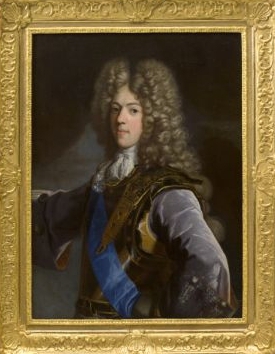
Konstanty Władysław Sobieski (1680-1726), the youngest son of Jan III Sobieski and Maria Kazimiera. After the king’s death, he almost always accompanied his mother and brother Aleksander. In 1698, after the division of his father’s estates, Konstanty received, i.a. the Zółkiew property, Wilanów and Kazimierzowski Palace in Warsaw. In the course of her stay in Rome, Maria Kazimiera planned to obtain a cardinal’s hat for Konstanty. Her intentions were thwarted by the uninhibited behaviour of prince who, while visiting his mother in 1701, got involved in an affair with Tolla, a Roman beauty also adored by Duke Gaetan Sforza, who wounded her in front of the Sobieski mansion, a deed for which he later formally apologised. In the first years of the Great Northern War, Konstanty supported his brother Jakub’s attempts to mount the throne of Poland. In February 1704 both brothers were kidnapped and incarcerated by Augustus II. In 1706 they were set free by the victorious Charles XII.
In November 1708 Konstanty unexpectedly married In Gdańsk Maria Józefa Wessel, whom he probably knew from childhood. He presented the bride with a life estate contract, considerably hindering the subsequent attempts of the Sobieski family, which perceived the relationship as a misalliance, to annul the marriage. The prince abandoned his wife already in December, leaving her in Gdańsk, and in spring 1709 he accompanied Stanisław Leszczyński in the region of Lwów, where he met Elżbieta Sieniawska, a hetman’s wife, who believed that in the prevailing political situation Konstanty’s election would be preferable to Augustus II returning to the throne. In subsequent years, the prince often stayed on his brother’s estates in Oława, Wrocław and Żółkiew. Suffering from rheumatism and seriously indebted, in 1725 Sobieski unexpectedly made amends with his wife, who offered him financial aid and brought him from Wrocław to Żółkiew, where he died and was buried in the parish church. The Żółkiew residence owes to Sobieski its impressive painting collection and abundant library.
We would like to inform that for the purpose of optimisation of content available on our website and its customisation according to your needs, we use information stored by means of cookies on the Users' end devices. You can control cookies by means of your Internet browser settings. Further use of our website without change of the browser settings means that you accept the use of cookies. For more information on cookies used by us and to feel comfortable about this subject, please familiarise yourselves with our Privacy Policy.
✓ I understand